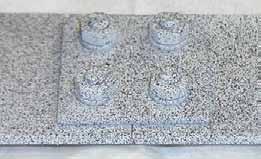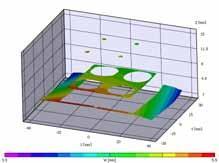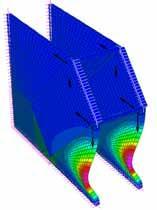Summary
Using a complementary approach of experimental measurements and detailed finite element analysis, we will develop more realistic yet computationally efficient global models incorporating bridge connection mechanical performance for ordinary, extreme, and degraded conditions. Due to years of limited investment and maintenance, the U.S. transportation infrastructure network (including approximately 6.5 million kilometers of highway, 700000 bridges, and 190000 miles of urban rail) has been pushed to the breaking point, and has received a grade of D for condition from the ASCE in 2009. An estimated $2.2T will be required for remediation over the next 5 years, and guidance is needed on prioritization of projects and the efficient use of funds.
Description
The NIST Physical Infrastructure Program will provide the critical measurement science needed to assess the condition of aging physical infrastructure and guide cost-effective strategies for its maintenance, repair, and replacement. Infrastructure management challenges in the U.S. have received considerable public attention recently due to several major structural failures (e.g., 2007 I-35W bridge collapse, 2009 failure on the San Francisco Bay Bridge, 2008 water main break in Bethesda, Maryland, 2007 steam pipe rupture in New York City). These failures have been costly, and even catastrophic in some instances. Dramatic improvements in condition assessment are necessary to prevent future failures, and to rationally prioritize resources. To enable the necessary improvements in infrastructure condition assessment, NIST must provide critical mechanical property data, advanced material and component models, new calibration services, reference artifacts, and advanced sensor technologies. The Infrastructure Connections Program is designed to addresses the first two items in collaboration with the Material Reliability Division, which will focus on the latter three items.
Major Accomplishments
In this program, we use an integrated, multi-prong approach in three key areas: experimental investigation of the mechanical behavior of connections, measurement of material properties at extreme rates and elevated temperatures, and numerical modeling of connections. These efforts will build on one another as we move forward. Early connection testing will be the basis for more complex connection testing, including connections degraded from corrosion or exposure to fire or shock loading. The experimental work will be guided by the numerical modeling results that will use the high-rate and elevated-temperature properties. Impact requires disseminating the results into the bridge community; therefore extensive outreach was a strategic goal in the project's first year.
Our outreach effort this year included participation in two international conferences as well as presentation at AASHTO (which sets the national specifications for highway bridges), and the Transportation Research Board (TRB) annual meetings. Multiple visits were made to the Federal Highway Administration (FHWA), especially the Turner Fairbank Research Center laboratories to develop collaborative efforts. We also hosted a one-day workshop including FHWA, TRB, NTSB, and the University of Rome. As a result, FHWA invited us to collaborate in their full scale gusset plates tests, a program arising from the 2007 I35W bridge collapse. Dr. Duthinh was appointed to NCHRP Project Panel C12-85 (Roadway Bridges Fire Hazard Assessment.) Preliminary research on the topic revealed that statistics on this issue are very incomplete. The panel has selected a contractor to collect more complete data, perform numerical modeling of fire effects on the most widespread types of bridges, assess risks, and propose standards for rehabilitating bridges exposed to fire.
Our experimental and numerical investigation of the behavior of bridge connections (bolted, riveted, and welded) in both as-built and post-service state under various loading conditions will be used to assess effects of service conditions and abnormal loads on performance of the overall structure. We plan to perform laboratory mechanical component tests of prototypical and salvaged connections to determine baseline metrology, and develop a numerical model in commercially available software. We will use these results to verify and validate the numerical model of the tested components, and abstract to a simplified numerical implementation for an aged connection in a complete structural model. We hope to collaborate in field testing and compare the resulting bridge performance with model predictions.
Our experimental connection work started by demonstrating the use of our 3-D digital image correlation (DIC) system for a reduced-scale double-lap bolted connection, Fig 1. This helped diagnose problems and required corrections for issues with lighting, camera angles, and analysis procedures. In FY10 the system will be used for the full-scale gusset plate experiments at the FHWA Structures Lab. In the future, this project will require dedicated laboratory facilities; therefore, we are renovating our expanded laboratory space.
In our numerical modeling of connections we have developed a finite element model (FEM) of gusset plates that can accommodate a variety of geometries and member stiffness but is simple enough to rapidly test many loading conditions. We verified it against existing experimental data. These efforts, Fig. 2, showed that the Whitmore length method recommended by FHWA (as emergency guidance for state DOT use) for load rating of gusset plates is conservative for compression and buckling (rating/ultimate 60 %), but is less conservative for large initial out-of-plane deformations. Also, the stiffness of the members framing into the gusset plate and the distribution of loads carried by the bolts or rivets in the direction of the load path strongly affect the gusset plate strength, but the FHWA guidelines do not explicitly consider these factors. We shared these results directly with FHWA and TRB.


Fig. 1 Double-lap bolted connection during bending. Top: painted speckle patterns. Bottom: measured positions of elements.

Fig. 2. Finite element model of a gusset-plate corner after applied loading that resulted in buckling of the plate.
Project Summary (PDF)

